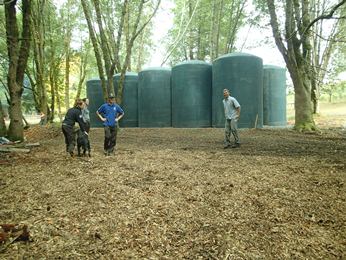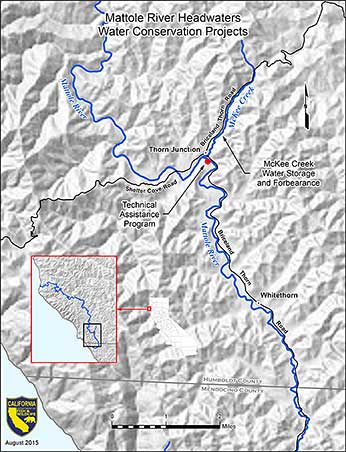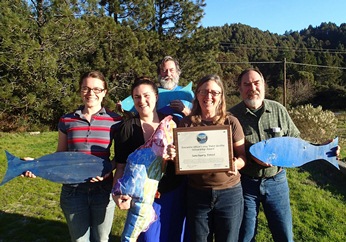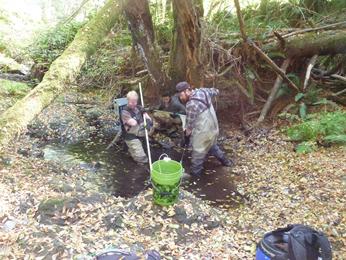(Mattole River Watershed, Humboldt and Mendocino Counties)
Species / Location

 Mattole river and Mckee Creek Map. (click/tap to enlarge)
Mattole river and Mckee Creek Map. (click/tap to enlarge)
The Mattole River Watershed is located about 200 miles north of San Francisco on California’s Lost Coast. The river flows about 66 miles northwest to Petrolia and the Pacific Ocean (see map). In the native language of the Sinkyone people, Mattole means “clear water”. The system was once abundant with native coho and Chinook salmon and steelhead trout. Post- World War II logging practices changed the landscape and river system, reducing original old growth coniferous forests to a fraction of the original stand. Mattole River coho salmon (Oncorhynchus kisutch) belong to the Southern Oregon Northern California Coast Evolutionarily Significant Unit (SONCC ESU) and have been listed as threatened under the Federal Endangered Species Act (ESA) since 1997. Statewide, coho salmon were formally listed as threatened under the California Endangered Species Act (CESA) in 2005. Chinook salmon (Oncorhynchus mykiss) found in the Mattole watershed belong to the California Coastal ESU and have been listed as threatened under ESA since 1999.. Some major human stresses contributing to recent and historic population declines include loss or degradation of habitat caused by dams, water diversions, marijuana cultivation, poor logging practices, agricultural land development and overfishing. Natural stress factors may include floods and droughts, poor ocean conditions, disease, predation, wildfires and poor water quality.
Purpose and Need for Projects
The purpose of the Conservation/Technical assistance program is to better prepare local landowners for extreme drought conditions and to protect salmon and steelhead by promoting water conservation on a watershed scale. This project will provide education and technical assistance to landowners and Mattole River communities as needed to help reduce human use impacts on stream-flows, fish and wildlife (Figure 1).
On McKee Creek, tributary to the Mattole River, up to 100,000 gallons of water will be stored in tanks purchased and installed with the assistance of this grant. Water use restrictions and forbearance will allow more water to remain in the stream during critical life history stages of endangered salmon and steelhead. With drought affecting everyone, storing water from the wet months for use during the dry months is being recognized and supported by the state. McKee Creek is a high priority tributary in the headwaters of the Mattole River with key spawning and rearing habitat. It has been prioritized because of its salmonid habitat potential, documented low flow problems in drought years, small population, and supportive landowners.
These projects are necessary because climate change and a nine year pattern of longer dry seasons have severely impacted the Mattole River salmon. In most of these low flow years, as rivers and creeks break up into a series of disconnected pools throughout the Mattole River watershed, thousands of juvenile salmonids have perished due to increased predation, low dissolved oxygen, and pools literally drying up (Figure 2).
 Figure 1 - Sanctuary Forest staff received the 2014 Water Quality Stewardship award for innovative storage and forbearance program.
Figure 1 - Sanctuary Forest staff received the 2014 Water Quality Stewardship award for innovative storage and forbearance program.
 Figure 2 - Michelle Dow (Mattole Salmon Group), Allan Renger and Alex Blessing (CDFW) rescue coho salmon from drying pool in Baker Creek.
Figure 2 - Michelle Dow (Mattole Salmon Group), Allan Renger and Alex Blessing (CDFW) rescue coho salmon from drying pool in Baker Creek.
Sanctuary Forest is a land trust whose mission is to "conserve the Mattole River watershed and surrounding areas for wildlife habitat and aesthetic, spiritual and intrinsic values, in cooperation with our diverse community". In their 2004 study, ‘Options and Obstacles: Living with Low Flows in the Mattole River Headwaters’, identified three main causes of the low flow problem: 1) climate change and longer dry seasons, 2) past and current land use practices that resulted in reduced groundwater storage and higher evapotranspiration rates, and 3) increased human use.
Partners
This is a collaborative effort with California Department of Fish and Wildlife, Sanctuary Forest Inc., and additional cost-share provided by Bella Vista Foundation.
CDFW
Sanctuary Forest
- Galen Doherty
(707) 986-1087